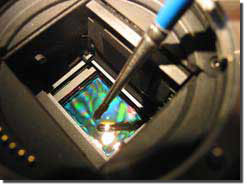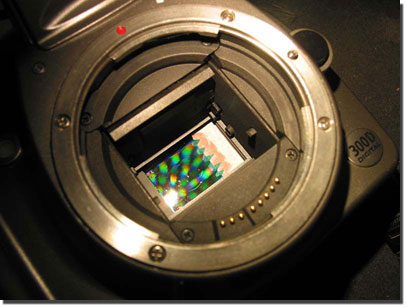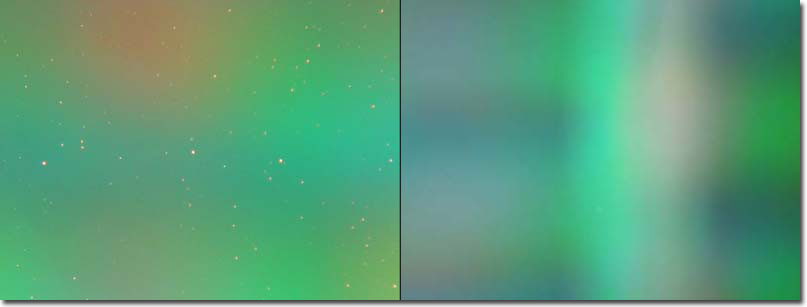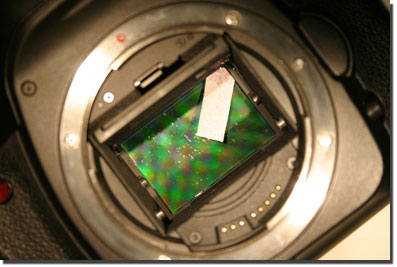Sensor cleaning with Discofilm
Occasionally it is necessary to clean the sensor of a DSLR. By its open design, dust can enter the mirror box and settle on the sensor during exposure. The camera has a function "sensor cleaning". When itís activated, the mirror turns away; the shutter opens and frees the sensor. What you see now is actually not the sensor, but the infrared blocking filter which is a few millimetres in front of it. So you will clean a piece of coated glass and not the real semiconductor. The filter consists of several layers, is very expensive and can not be changed easily. Now we know, whatís good for cleaning filters is also good for cleaning "sensors".
 On the internet a huge number of different possibilities to clean sensors can be found. It starts with cotton applicators soaked with methanol and ends with special cleaning brushes. With Discofilm I want to do it in another way.
On the internet a huge number of different possibilities to clean sensors can be found. It starts with cotton applicators soaked with methanol and ends with special cleaning brushes. With Discofilm I want to do it in another way.
The original area of application for Discofilm is cleaning of records. The transparent, water soluble liquid with viscosity of honey is painted on the surface; it dries within one hour and forms a thin foil. In this foil all dust particles are enclosed and will be removed by peeling off the foil without leaving any residue. The result is an absolutely clean surface. However we have to overcome a few difficulties to be able to clean a sensor with Discofilm reliably. The main problem is to find a point in the deep mirror chamber on which the dried foil can be taken off. Letís do it step by step:
 The Discofilm is painted on the blocking filter with a small brush. This is unproblematic, since the brush doesnít get in contact with the glass. Thereís always the viscous Discofilm between the hairs and the surface. Be aware that no liquid can enter the small gap between the glass and the covering framework. The risk is small but it could complicate taking off the foil afterwards. I recommend a small gap to the sensor border.
The Discofilm is painted on the blocking filter with a small brush. This is unproblematic, since the brush doesnít get in contact with the glass. Thereís always the viscous Discofilm between the hairs and the surface. Be aware that no liquid can enter the small gap between the glass and the covering framework. The risk is small but it could complicate taking off the foil afterwards. I recommend a small gap to the sensor border.
 A slash has to be integrated otherwise you canít peel off the dry foil. Just put a small piece of paper on one of the edges. The paper has to be absorbent and tear proof. It absorbs the wet film and during the drying process both build a fixed connection. Ensure that the camera is orientated horizontally during drying. Now you have two choices. You can leave the sensor cleaning function activated and the film dries with open shutter. Depending upon temperature, air humidity and thickness of film it will take one to three hours (rather wait longer, than to be to impatient). A fresh charged camera battery has no problem to hold the shutter open for four hours or even more. Especially for beginners in Discofilm cleaning this is the recommended procedure. When you are on journey and have to save battery power, you can deactivate the sensor cleaning. The shutter gets closed and the mirror places in front of it. The paper has to lie flat on the sensor; otherwise the shutter could be damaged. Of course this will extend drying time. Independent of your choice, do not attach a lens to your camera, since this would slow drying dramatically. Covering the opening with a sheet of paper is completely sufficient to prevent dust from entering the mirror box. Do not try to accelerate the drying with a hair-dryer, leave it at room temperature. After drying itís the best moment you can imagine for blowing out your camera. The sensor is safe under Discofilm, the mirror protects the focusing screen and the shutter is turned away. Just be aware of the auto focus optics in the base plate. Now itís time for peeling off the film. Grab the paper slash with a pair of tweezers and pull, thatís it. Discofilm will not leave any residues.
A slash has to be integrated otherwise you canít peel off the dry foil. Just put a small piece of paper on one of the edges. The paper has to be absorbent and tear proof. It absorbs the wet film and during the drying process both build a fixed connection. Ensure that the camera is orientated horizontally during drying. Now you have two choices. You can leave the sensor cleaning function activated and the film dries with open shutter. Depending upon temperature, air humidity and thickness of film it will take one to three hours (rather wait longer, than to be to impatient). A fresh charged camera battery has no problem to hold the shutter open for four hours or even more. Especially for beginners in Discofilm cleaning this is the recommended procedure. When you are on journey and have to save battery power, you can deactivate the sensor cleaning. The shutter gets closed and the mirror places in front of it. The paper has to lie flat on the sensor; otherwise the shutter could be damaged. Of course this will extend drying time. Independent of your choice, do not attach a lens to your camera, since this would slow drying dramatically. Covering the opening with a sheet of paper is completely sufficient to prevent dust from entering the mirror box. Do not try to accelerate the drying with a hair-dryer, leave it at room temperature. After drying itís the best moment you can imagine for blowing out your camera. The sensor is safe under Discofilm, the mirror protects the focusing screen and the shutter is turned away. Just be aware of the auto focus optics in the base plate. Now itís time for peeling off the film. Grab the paper slash with a pair of tweezers and pull, thatís it. Discofilm will not leave any residues.
Before cleaning your camera you should get familiar with the proceeding. Take a photo filter for testing and be amazed how good it works.

Here are two pictures of the sensor under the microscope, left is before and right is after cleaning. The dust particles which can be seen in the first picture are such small they were barely visibly in pictures, but I want to demonstrate how efficient Discofilm cleans.
24 x 36mm sensor DSLR
 The method described above works well with crop cameras. The small sensor and paper slash have plenty space in the mirror box. For other cameras like the Canon 5D I have made the procedure more general.
The method described above works well with crop cameras. The small sensor and paper slash have plenty space in the mirror box. For other cameras like the Canon 5D I have made the procedure more general.
Itís now a two step process. The whole sensor surface is painted with Discofilm. Now let it dry. The second step is integrating the paper slash. Put a small drop of Discofilm in one of the edges (I prefer the side of the mirror). It will solve the dried film. Now put the paper slash on it and they will build a solid connection after drying. Of course this general method works on crop cameras too.
Comparison with other cleaning methods
Advantages
- Discofilm does not leave residues after drying.
- No risk to scratch your sensor.
- With this method the dust is really removed from your sensor and not shifted to another edge.
- Discofilm does not forget dust grains. Each area witch had contact with the film will be dust free.
Disadvantages
- It takes long, until the film is dried.
- Discofilm can only solve water-soluble materials. Fingerprints for example will not be removed completely.
Problems
 If Discofilm is applied to economically and the film gets to thin, it can brake during peeling off and part of it stays on the sensor. Donít get nervous and start applying Discofilm again.
If Discofilm is applied to economically and the film gets to thin, it can brake during peeling off and part of it stays on the sensor. Donít get nervous and start applying Discofilm again.
Sometimes the paper slash tears. This is a sign that the paper youíve chosen is not tear proof enough. Attach a new paper slash.
If you dry the film with closed shutter, do not move the camera uncontrolled until you are sure the film is dry. Otherwise the shutter could get glued.
Discofilm? Where can I get it?
This can be a real problem. Discofilm is not sold in many countries. This was one of the reasons, why I have developed a version which is optimized for DSLR sensor filters. The shop and plenty of information can be found here: www.sensor-film.com
The cleaning Video
I made a short video where you can see Discofilm in action: Video (right click and select "save target as") file size: 9.4 MB; video codec: XviD, Audio is still German, I will change that soon.
Everybody does the cleaning on own personal responsibility.
Last change: 14.03.07